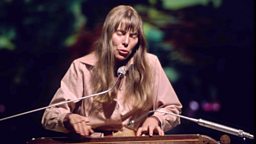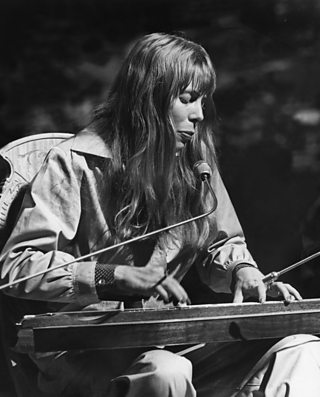Seven life-changing things that shaped Joni Mitchell
Joni Mitchell’s songs have soundtracked many lives and her pioneering work changed music forever. In Legend: The Joni Mitchell Story, the singer-songwriter Jesca Hoop takes listeners on a fascinating journey through Joni’s extraordinary life and career. The Radio 4 podcast weaves together archive interviews, Joni’s famous songs and captivating commentary from friends, collaborators, biographers and admirers.
From a childhood bout of polio to a spring spent in a cave in Crete, here are seven things the series reveals about how Joni’s incredible life experiences shaped her music.

1. Growing up in remote prairie towns
Born in 1943, Joni Mitchell spent her childhood in small towns on Canada’s vast, rolling prairies – Maidstone, Saskatchewan, where her family moved after the war, was two hours’ drive from the nearest big city. Biographer David Yaffe sees this prairie upbringing as a key influence on Joni’s creativity: “This was a very, very remote place. Joni had to find a whole world in her imagination.”
Alongside the image of Joni as a prairie girl, NPR music critic Ann Powers argues there’s another side too: that of a suburban child listening to her parents’ records and staring out of the window, “dreaming herself out of a box”. While in Maidstone, Joni lived beside a railway track and loved to watch trains arriving and leaving from the front window, wondering where they were headed. Powers says a sense of movement is “in her music… It's in her complicated guitar tunings. It's in her fascination with rhythm and her phrasing which really is so free.” Many of Mitchell’s earliest original songs have a sense of movement and restlessness, from Urge for Going to Day After Day, with its “miles and miles of railroad track”.
2. Surviving polio as a child
In 1953, a wave of polio infections swept across Canada and Joni fell seriously ill. Quarantined on a hospital ward for months, she was told not to move in case it made the illness worse. Joni endured painful treatments and had to fight to learn to use her legs again. She has said that losing her mobility “made me have an inner life and made an artist out of me”.
It made me have an inner life and made an artist out of me.Joni Mitchell on losing mobility from polio
As a teenager Joni loved to dance. She once said, ”When I got [my legs] back, I rock ‘n’ roll danced my way through my teens.” She once credited these rock ‘n’ roll dances with gifting her a sense of rhythm – “Every guy was like a different drummer” she once told an interviewer. She used the money she won in dance competitions to buy records; some favourite artists were Miles Davis, Edith Piaf and Lambert, Hendricks and Ross.
The polio weakened Joni’s left hand. This led her to explore alternative ways to play the guitar, developing her signature distinctive tunings and “weird chords”. Music critic Lindsay Zoladz explains how Joni found herself “twisting the tuning knobs until she finds the chord that sounds like what she hears in her head.” Joni has called them her “chords of inquiry”.
3. Giving up her daughter – and finding her again
After less than a year at art school in Calgary, Joni discovered she was pregnant. She and the father of the child, her friend Brad MacMath, headed to Toronto where there was a good music scene, and where she might be able to conceal her pregnancy from her parents. Joni later said, “To be unmarried and pregnant at that time… It was like you murdered somebody.” She worked in a department store and played gigs in ”scab clubs” to earn money (as most clubs in Toronto required you to have Union membership, which she couldn’t afford). Brad left for California after just a few months in Toronto: ”My daughter’s father left me three months pregnant in an attic room with no money and winter coming on and only a fireplace for heat. The spindles of the banister were gap-toothed – “fuel for last winter's occupants”, Joni wrote later. In February 1965, at the aged of 21, Joni gave birth to a daughter. She named her Kelly, after the vivid shade of the colour “Kelly Green” that represents new growth. In her song Little Green, which she included on her 1971 album, Blue, she sings: “Call her green and the winters cannot fade her”.

Initially, Joni put Kelly into foster care, hoping to come back for her once she had more money. But she ended up putting her daughter up for adoption. Joni has described the loss of her daughter and what she has referred to as a “bad marriage” (to folksinger Chuck Mitchell) as a “catalyst” that brought her songwriting gift “to fruition”. Up until that point she had sung folk songs and standards, but now she began to write her own material – staying up late in a diner near her Detroit apartment, penning songs as “a form of exorcism”.
In 1982’s Chinese Cafe Joni wrote, “My child’s a stranger / I bore her / But I could not raise her.” But 32 years later, she and Kelly, now Kilauren, were reunited after news of her adopted daughter was leaked to the papers. In a song released soon after, Stay in Touch, Joni sings: “Our roles aren’t clear / So we mustn’t rush... I’m grinning like a fool”.
4. Missing Woodstock
In August 1969, Joni was due to play the era-defining Woodstock festival, alongside Jimi Hendrix, Janis Joplin, Jefferson Airplane and The Who. But the huge crowds flooding to Max Yasgur’s farm had made getting in and out of the festival site difficult, so her management decided she should stay at home so she could make it to a planned TV recording. As Joni watched Woodstock unfold alone from her hotel room in New York, she composed a mournful melody about that moment that would become its ultimate anthem. Although Joni hadn’t hit huge fame yet, Woodstock became a Top 10 hit in the hands of Crosby, Stills and Nash, and a UK number one for Matthews Southern Comfort.
5. Retreating from the public eye
Throughout her career, Joni has had several periods of complete retreat from the public eye. In 1970, with her face adorning billboards and Rolling Stone magazine, a Grammy win under her belt for her album Clouds, and Ladies of the Canyon about to be released, Joni’s star was rising fast. But fame sat uneasily with her and she wanted time to write and recharge creatively. She cancelled everything and travelled to Europe, ending up in a cave in Crete. Cocooned there amidst a community of hippies, Joni was inspired to start writing songs that would later become her groundbreaking album Blue.
After the release of Blue, an album that was, in Joni’s words, “unprecedented in its vulnerability”, Joni withdrew to Canada, bought 40 acres of coastal land and built a simple stone cottage. She lived there alone with no electric light, describing it as “like a monastery” and “a combination of caves in Greece, coffeehouses in New York, and a prison cell”. Again, Joni used her time to write songs, and tried to recover from a break-up by reading self-help books and Nietzsche.
6. Meeting jazz great Charles Mingus
A lifelong jazz fan, Joni learned in 1978 that the great African American jazz bassist and composer, Charles Mingus, wanted to work with her. Gravely ill with motor neurone disease, he was keen to collaborate on a musical interpretation of T. S. Eliot’s The Four Quartets, with Joni re-writing Eliot’s poems in a colloquial voice.
He had a great spirit and it was an opportunity to apprentice under a great master.Joni Mitchell on working with Charles Mingus
Initially, she couldn’t see how it would work, and turned the project down. “Poetry is like cracking sunflowers with your nails to get the meat out,” she has said, “it’s a lot of work for very little reward.” But Mingus met her in person and convinced her, for the first time, to collaborate on an album. “You know, he had a great spirit and it was an opportunity to apprentice under a great master,” she says.
Released months after Mingus’s death, the experimental jazz album wasn’t the hit Joni had hoped for. But she had worked on it with an amazing list of musical greats, and formed lasting friendships.
7. Surviving a brain aneurysm
In 2015, Joni had a sudden and unexpected aneurysm. When she was found on the floor at home, she had been unconscious for three days. The trauma to her brain left Joni unable to walk or talk. But she fought hard to regain her abilities, telling friend Cameron Crow, “I came back from polio. So here I am again, and struggling back.”
As Joni’s recovery progressed, she began hosting intimate jam sessions at her house in Bel Air. Organised by singer-songwriter Brandi Carlile, these gatherings included young musicians as well as legends such as Paul McCartney, Elton John and Herbie Hancock. Over time, Joni went from watching others to singing herself. Musician Blake Mills was in the room the first time she picked up a guitar. Mills recalls, "She was just strumming it and kind of remembering how to play, because I think it had been years since she had even held the guitar.”
A year later, seven years on from her aneurysm, Joni performed in public again for the first time. Musician Alison Russell describes the power of her performance of Both Sides Now: “Hearing her sing it in her lived-in voice now, you feel the song even more. The song wasn’t complete ‘til she sang it now. The deep tones carry further than the clarion high notes of her youth.”
More from ���˿��� Radio 4
-
![]()
Legend: The Joni Mitchell Story
Joni Mitchell's influential life and career, told in her own words.
-
![]()
Paul McCartney: Inside the Songs
Paul McCartney talks about his life and song-writing through the prism of 10 key lyrics.
-
![]()
Add to Playlist
Cerys Matthews and Jeffrey Boakye explore the rich web of connections in music, from Beethoven to Beyoncé.
-
![]()
Soul Music
Series about pieces of music with a powerful emotional impact.





